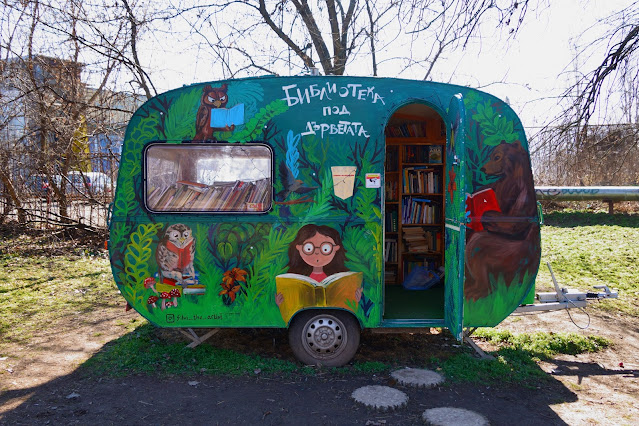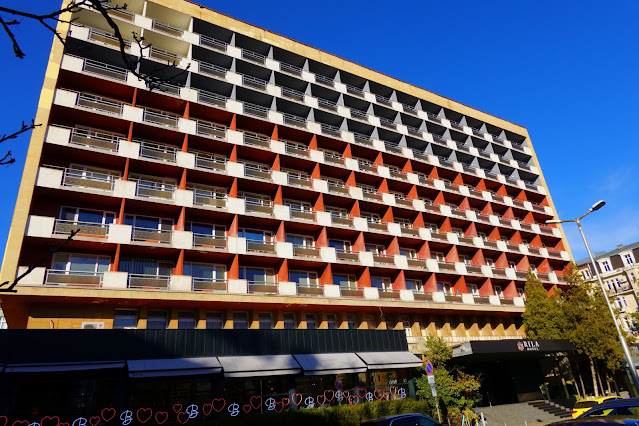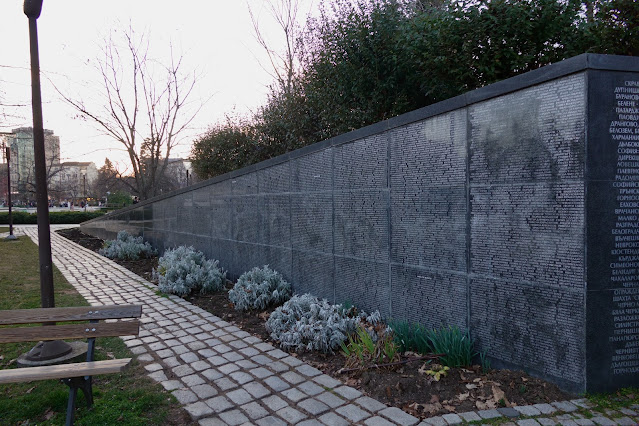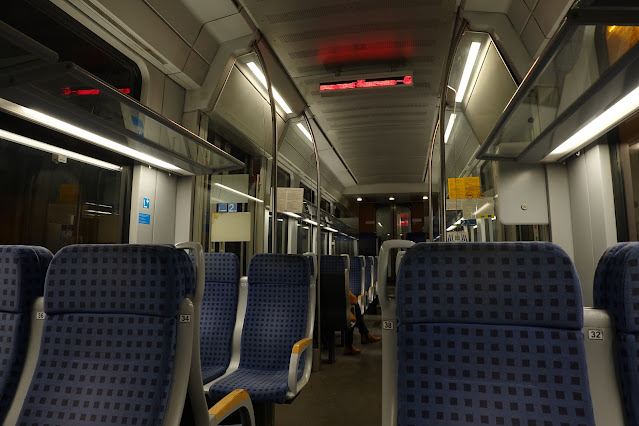Tidbits of Bulgaria Tour
This is not a comprehensive essay on visiting Bulgaria. It is a collection of my observations and my own reflections.
Like many Eastern European countries, Bulgaria is underappreciated. It gave me a great first impression, and never disappointed me during my tour.
Sofia
Beautiful Sofia airport with mountains in its background welcomed me with unbelievable convenience on March 5, 2025.

The border control officer smiled and stamped my passport after I answered his routine question regarding my travel purpose - touring. The metro station was right in front of me after I exited the airport hallway. A policeman guided me to the metro entrance after he noticed I was trying to use my credit card to purchase a ticket at a kiosk. I just needed to tap my credit card at the entrance to enter the platform.
Metro M2 line took me to the center of Sofia - Serdika. It was a short walk to the M4 platform, and M4 took me to the Central Bus Station, a 5-minute walk to my hotel. The metro fare for the entire trip was $0.88.
I have been to two dozen countries since Google Maps started to track me in 2018. As far as I am concerned, Sofia's public transportation is the best, not because of fancy, shiny vehicles (their vehicles tend to be old), but for unbelievable convenience. You are a few minutes away from a bus station anywhere in the city.
You just tap your credit card to pay on any vehicle ($1). Here is the kicker: The system tracks your credit card payment so that you will never pay more than $2.4 a day, no matter how many bus, tram, or subway trips you take. In other words, your credit card becomes a daily pass (cost: $2.4) automatically if you use the public transportation more than twice a day.
I went to a Minimart store across the street to get my dinner and got enough for about three meals. The lady there noticed me using a translator and came to me to explain about different Bulgarian drinks and foods. The bag of goods cost $14.67.
Like a typical Eastern European city, Sofia's architecture is a mixture of buildings from different historical periods, with the Soviet era leaving a big footprint.
I did not know that the Siemens tram, built in 1935, is a tourist information center when I passed by and took a picture of it. I thought it was for exhibit only.
The ancient town of Serdika was founded around 2000 BC. Its buildings were buried underground by later development. Its excavated part is an open museum.
You can have a virtual tour of the reconstructed ancient town with a phone while you are on the site.
Sophia has impressive large parks that cover about a quarter of the city's urban area. The National Palace of Culture is one of them.
The lovely Lovers' Bridge connects the National Palace of Culture to the 2-km long South Park. The bridge had an educational exhibit of European Long-Term Ecosystem Research (eLTER).
South Park is a large park with an irregular shape with different themes. The southern part is geared for nature embracing, and the northern part is mainly for playgrounds.
The best park for birding is probably Borisova Gradina Park, where there are many fewer visitors than in other parks. I saw and heard quite a few great spotted woodpeckers.
Another good park for birding is West Park, where I saw Eurasian jays, European robins, common buzzards, and many others.
Sofia's public transportation is the best that I have ever seen after having been to two dozen countries. One just needs to tap a credit card on any bus or at a subway entrance to pay the fare. The system will track your credit card and turn it into a daily pass if you have used it more than twice in a day. The daily pass costs 4 lev ($2.33).
Like many other former USSR publics or satellite countries, Bulgaria still has massive Soviet residues, such as seas of brutalist apartment complexes. It is on the higher end, together with Ukraine and Romania, much more than the Baltic states, Poland, and Czechia. I joined the fascinating Communist Tour. The tour guide, Nicola, was excellent. It started from the Sofia City Court.
The memorial to the victims of communism in Sofia is like a smaller version of DC's Vietnam Veterans Memorial. The latter were also killed by communists (Vietnam communists with massive critical support from Chinese communists and Soviet communists).
I brought my ski boots and helmet with me, so I contemplated going to Vitosha Mountain for skiing. However, the temperatures of Sofia reached almost 20°C. I decided to go hiking there. I wonder if Sofia is the only major city in the world where you can take a regular bus to a mountain over 1 km high. The peak of Vitosha stands at 2277 m. Bus 66 starts from Metro Station Vitosha and ends at Aleko Hut at 1840 m.
I was surprised by the excellent snow condition on the mountain.
I wanted to hike to the peak but could not find the trail. I took the Devils Trail to hike back to the city. I hiked down by relying on signs, Google Maps, and guessing. I intended to head to the area around Dragalevtsi Monastery, but ended up in Bistritsa by taking Enduro Bistritsa trail. The hike was enjoyable the whole way.
Bansko
The 2.5-hour bus journey from Sofia to Bansko on March 8 was a very pleasant, scenic ride.
Bansko is probably one of the prettiest towns in Bulgaria. It has only about 10k local residents. It is a small city with no buses. There is no need for buses. You can walk from the southern end of the town - the train station- to the northern end of the town - the ski gondola station- in half an hour.
Its streets are clean and tidy.
A British friend I met at the Communist Tour in Sofia recommended the Smart Ski Academy to me. It turned out to be indeed a very good company with excellent service. It is interesting that they did not ask me for a cash deposit or my passport. They just asked me to fill out a form with the information about my phone number and my hotel without any verification. I did not need to pay anything until I told them that I was done with the rental skis. I think this basic trust says a lot about the culture of Bulgaria. I bought my own helmet and ski boots, so I just needed skis and poles. I left my backpack in their room during my skiing, then I left my helmet and boots with them when I went back to my hotel.
Bansko is the largest ski resort in Eastern Europe, with 75 km of pistes (Russia is no longer a part of Europe). Its pistes are diverse. It has a few wide slopes.
The only downside of Bansko Ski Resort is the time you spend on getting to the real ski base, Banderishka meadow. You may wait in line for 20 to 30 minutes to get on the gondola, which will take over 20 minutes to reach Banderishka meadow. You can ski down all the way to the gondola station via a ski road. You may need to do some X-C skiing for 1 km or so near the bottom because the road is flat. This means you may need to spend 40 to 60 minutes to reach the base. If you go there after 10:30 in early March, there should be no lines, and you can get on the gondola quickly.
The long line before the gondola station:
The gondola:The base, Banderishka meadow.
The highest lift station Todorka (there are two lifts that reach Todorka):
I love the large slopes with trees buried in the snow where you ski between tree tops.
You can see the town of Bansko from the top:
This is the small Bansko railway station:
The scenic ride through beautiful mountains from Bansko to Septemvri took 4.5 hours, covering 118 km. It is like a slow rollercoaster with many ups and downs. The train was only 20-30% full when I took it, which is great for people like me who carry suitcases. The inter-city train connecting me to Plovdiv is fast and very modern:
Plovdiv
Since I grew up in a country under the rule of a party founded by the Soviet Union, I am always interested in how the USSR influenced an Eastern European country. A uni can get some sense from local museums. I visited the Regional Ethnographic Museum – Plovdiv and the Historical Museum. To my surprise, the museums give the impression that the Soviet era never existed. I don't know if I missed any. I could not find anything related to that era.
Like most European cities, Plovdiv's old town should be at the top of the list of places to visit. It is fairly small. Just touring its streets would take less than half an hour. The small tourist information center there is good place to stop by. The two museums - Regional Ethnographic Museum Plovdiv and Historical Museum - are educational. ItsStreet of crafts allows you to interact with local artists.
Nebet Tepe, the fortres that offers a high point to view the beautiful city, is probably a must-visit.
When I tried to visit the Ancient Theatre of Philippopolis, I found they do not accept credit card payment and I do not have any Bulgarian Lev. The gatekeeper asked me to ahead to visit it, and pay the next day. I suspect she just wanted to offer me a free entry. I find some $US and insist on giving them to her.
I think the most fascinating ancient structure is the Ancient Stadium of Philipopolis. I visited the place when it was about to close, so the employee offered me a private 3-D film viewing. The movie recreates the competitions at the stadium almost two thousand years ago.
Like every other major Easter European city, Plovdiv has its share of Soviet Era relics. This is the Monument of the Red Army "Alyosha"
The night scene of Plovdiv is quite pretty.
Varna
The brunch at Kitchen Fast Food was excellent.
The collection of the Varna Museum of Archaeology is very impressive.
The entire Black Sea coast of Varna is public, not private waterfront houses. It includes the 2-km-long Sea Garden and the 1-km-long Varna Beach, both of which are beautiful and pleasant. I toured them twice, on March 14 and March 15, hours before my departure.
I love street markets like this in Europe that open daily. This is the Blue Market on ul. "Ruse".
My lodging place, run by a very friendly Varnea, is a studio with a full-size kitchen, a bathroom, and a washer/dryer, 5 minutes walk from the main train station.
Varna does not have Uber or Bolt. I am always leery of taxis. Glowing reviews pointed to Triumf Taxi. I ordered a ride online to get to the Central Bus Station. It worked out very well. The car was clean and the driver was very polite.
I booked a ticket with the Ukrainian bus company Like Bus. The bus was supposed to depart at 15:00, but it did not arrive until 20:30. The bus started from Istanbul but was stuck at the Turkey-Bulgaria border for many hours. Fortunately, I got hold of the Like Bus on Telegram, and they provided me with a link for live tracking of the bus, which is incredibly accurate.
The trip to Bulgaria was very delightful and educational.

















































































Comments
Post a Comment